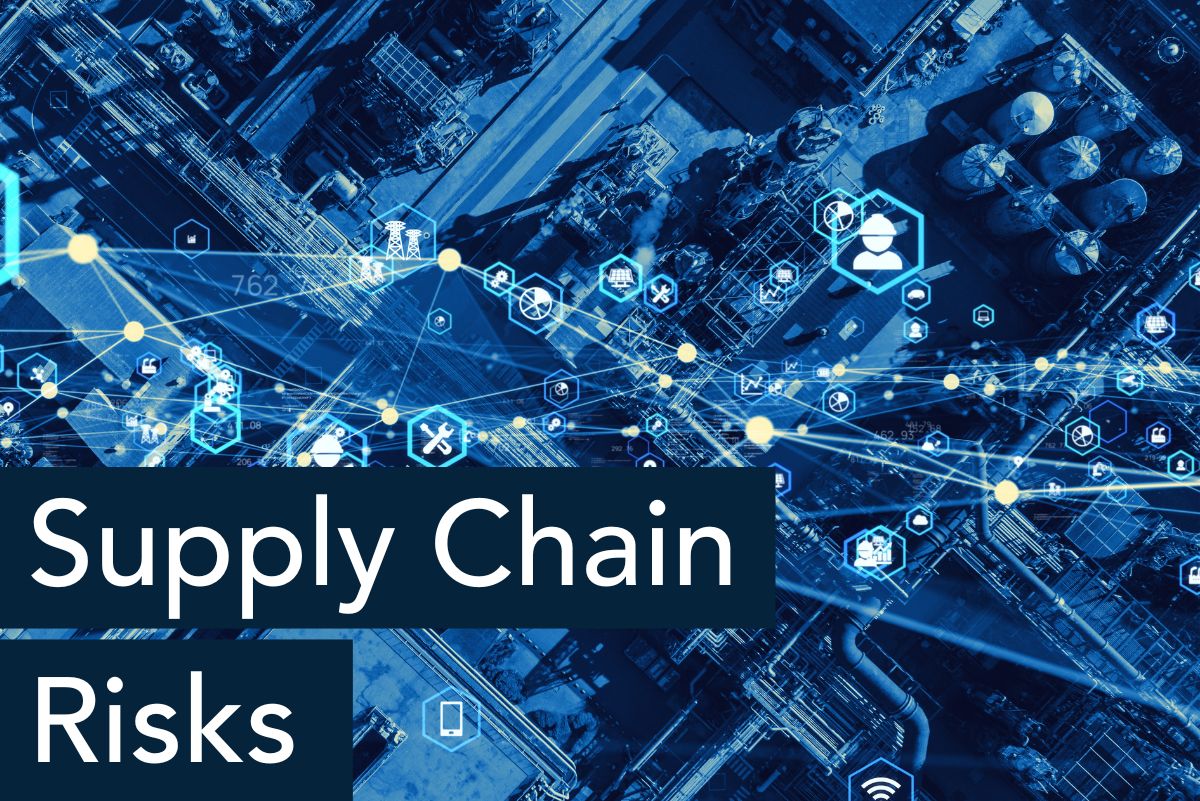Top 10 Supply Chain Risks in 2023 & ways to manage them!
Your supply chain isn’t some fit-and-forget part of your business operations. As companies making everything from cars to computers have long known, optimizing your input sources and how they interact is a strategic advantage that gives you the jump on competitors.
Your supply chain offers opportunities to shave costs or increase margins across the whole journey… from a distant factory to your warehouse shelf.
Yet those same companies have discovered that a lean and taut supply chain carries its own risks. Over-reliance on a single source makes it cost-effective but brittle. A beatdown on price in one process makes your supplier value you less, risking lower commitment levels. And IP concerns can mean your innovative design ends up in someone else’s bestselling SKU.
These worries aren’t new. But with 2023 around the corner, the risks have morphed and broadened. In the wake of a pandemic, with turbulence in Europe and a slowdown in Asia, it’s important to spell out emerging risks alongside existing ones.
That’s why we’ve put together this latest guide to supply chain risks and strategies for managing them.
- Internal risks – the ones that already exist
- External risks – looking outside
- Existential risks – the world-changing events
The supply chain isn’t a chain anymore!
First up, let’s recognize even the term “supply chain” is looking a little out of date. For most companies, it’s been some years since their string of raw inputs and transformed outputs was a simple series of events on a timeline. In the 2000s the supply chain became more of a supply web, with second sources and backup plans baking complications into the mix.
Today, it’s evolved even further – a supply network, a 3D map of interacting activities with a mass of unforeseen outcomes hiding in the risk model.
It means more potential. But also more risks. Traditionally, supply chain risks come in two flavors: external and internal. Let’s add one more: “existential”. Risks so huge they pose a threat to your company’s survival. (That’s the thing about rare and unexpected events: they tend to happen fairly regularly) Let’s look at internals first.
A series of internal events: managing risks already there
Internal risks – part of your supply chain planning and often within your control – are more visible, which often means more manageable. But that doesn’t make them any less dangerous to your business. The main ones are:
1. Production control risks
Core for any manufacturer is product quality. Even a small industrial unit may take in parts from a hundred suppliers all over the world; a change in one product parameter or material limitation can make that part useless in your finished product. That change may not be your fault – but it’ll certainly be your problem.
All this creates an additional burden of quality control. So if you source from outside and haven’t made checks in a while, it’s worth auditing your supplier list and seeing where parts have changed in spec, increased in price without increasing in quality, or even been quietly substituted for “equivalents” you never agreed.
What’s different in 2023: after years of pandemic disruption, the manufactured parts sector worldwide is suffering a serious skills shortage – including the workshop of the world, China. Raw materials are costing more, and there are more bidders for the products being made – which could leave you high and dry if your price ceiling can’t match that of a competitor. The time to check is now.
2. Business information risks
A smoothly functioning supply chain relies on information. And the higher the number of interactions, the greater the need for it. If you look along a single process in your web of suppliers, you’ll probably find “information gaps” where the information you need either isn’t available or isn’t in the right format for your systems.
All of which creates extra work … and risks. Because it leads people along the chain to assume and estimate rather than confirm. Is there a way you could bring all the sources of information you need into a “Single Version of the Truth”, so any discrepancies could be seen and solved early?
What’s different in 2023: applications have successfully managed supply chains since the 90s, but many weren’t interoperable, which created the same problems of data inconsistency and incompatibility. Today, web applications and cloud services can connect all the data – but many manufacturers aren’t aware of the opportunity this represents. It’s vital to stay ahead of the curve.
3. Planning and forecasting risks
On a related note, it’s only good information that can deliver good predictions and across much of today’s global supply network, information systems aren’t fully joined up. This means reports, charts, and other predictive tools have to rely on incomplete information too.
(Note “incomplete”. Not necessarily “wrong”. The information on your monthly report may be accurate in itself, but missing parts that matter. At a minimum, make sure you know what you don’t know.)
What’s different in 2023: Shocks in the air and surface transport sectors have put some services on a startling cost spiral, meaning the total cost of your inputs might be uneconomic tomorrow even if the price-per-unit looks reasonable today. Ask yourself if your predictive models really take everything into account.
4. Mitigation and contingency risks
In turbulent times, the most important plan is an escape plan. What if those production costs rose not 10% but 110% in a single year? It’s happened for many manufacturers, from American building materials to Taiwanese chips.
To manage these, it’s necessary to agree in advance at what point you “get out of Dodge” – find alternative arrangements rather than manage through with existing ones, with a supply chain risk management plan. But by the time you need a second source, it’s too late. Always have a plan in place that imagines bad scenarios… ahead of time.
What’s different in 2023: Economic ripples are swirling around the world, many originating in China’s manufacturing hubs – normal for the business cycle. But the size of these aftershocks is likely to be bigger in 2023, as previously hidden problems bubble to the surface. Covid-19 may be over, but its supply chain risks persist.
The external view: looking more broadly
Let’s pan out and look beyond your own supply chain at the world events that could affect it. Not always fun to think about – but thinking is better than the alternative.
5. Market supply and demand
Demand rises and falls for any product, and it’s not just a matter of fashions and fads. So it’s important your supply chain management looks at global patterns of consumer and business demand, including those that aren’t about your product quality or price: legal reforms, economic contractions, commodity prices that make it impossible for your inputs to be produced competitively. It might sound like overkill for a plastics manufacturer in Hawaii to be watching the price of crude oil in Texas – but it involves a critical input.
What’s different in 2023: Multiple factors affecting supply and demand are converging, from political and economic risks to societal changes that can make profitable products obsolete overnight. And these factors are changing at an unusual speed. Keep your eyes on the “landscape” around everything you make.
6. Competitive invention and innovation
One thing that hasn’t slowed down is the pace of change. Enabled by technology, products and services are evolving and improving faster than ever. These competitive pressures can show up as sudden declines in your customer base, with customers switching and churning on a daily basis.
What’s different in 2023: Anecdotal evidence suggests customer loyalty has become a lot more fickle in recent years – which means your customer base can’t be taken for granted. As if you thought the job of supply chain management wasn’t complicated enough, it’s now necessary to be an expert on competitor intelligence, too.
7. Environmental awareness risks
Everyone loves being green – which is an opportunity, but also creates additional burdens on supply chain managers. The sourcing web is now wrapped in layer after layer of CSR (Corporate Social Responsibility) constraints, new laws and legal principles, and a patchwork of different regulations across borders. All of which takes extra time and effort to deal with.
What’s different in 2023: With Western (and many Eastern) economies facing trouble ahead, governments are relaxing some policies on green issues – but their citizens are more than compensating. Buyers across all sectors, both consumer and B2B, are making choices based on their own values rather than just legal restrictions. Don’t be caught out by someone’s CSR policy.
Existentially aware: what you don’t want to think about but must
Finally, the big ones are world-changing events that sometimes seem to belong more in fiction than fact. In 2023 and beyond, it’s the supply chain manager’s responsibility to think about the unthinkable and how their companies would deal with it.
8. Entire economies simply collapsing
Not all apocalypses involve zombies. The world’s looking like an uncertain place in 2023, with a lot of countries financially leveraged in ways that may prove dangerous. If a currency collapses or a supply shock hits, entire industry sectors could go down with it – not just bending your supply chain but breaking it.
Are both your primary and secondary sources in the same business cluster or city? Consider what would happen if both were unavailable tomorrow.
9. Conflict spreading across borders
Nobody likes to think about the side effects of NATO going into Ukraine, or China taking action on Taiwan. But these things are all more possible in 2023 than a few years ago. And their effects are felt far beyond their borders.
Shipping and air travel, local transport and delivery, and even lines of communication like the web may be disrupted for years. If your sources span risky geography, you’ll need a plan.
10. Markets moving on
Multiple industries face extinction in 2023. Of course, this has always been the case – horse-and-cart makers stopped being investment grade around 1910. But the deep involvement of footloose capital in today’s markets can mean a business venture – even an entire sector becoming unviable in a short span of time once investors withdraw their money. Are any of your suppliers in such a sector? Again, cast a critical eye.
Work for the best outcome but plan for the worst
That’s the supply chain picture in 2023!
It may not be pretty, but don’t be discouraged. The world in 2023 offers more opportunities and potential than ever before – if you can manage its risks effectively.
That’s where AIMMS comes in. Our analytics platform enables smarter decision-making by helping you plan and design your supply chain at the right level of detail – including scenarios that haven’t happened yet, so you can see their effect on an accurate model of your supply network called a supply chain digital twin. It’s a “safe space” for testing the effects of supply chain shocks, ahead of time and across multiple objectives, using advanced mathematical modeling techniques to give you the best outcomes in any situation.





